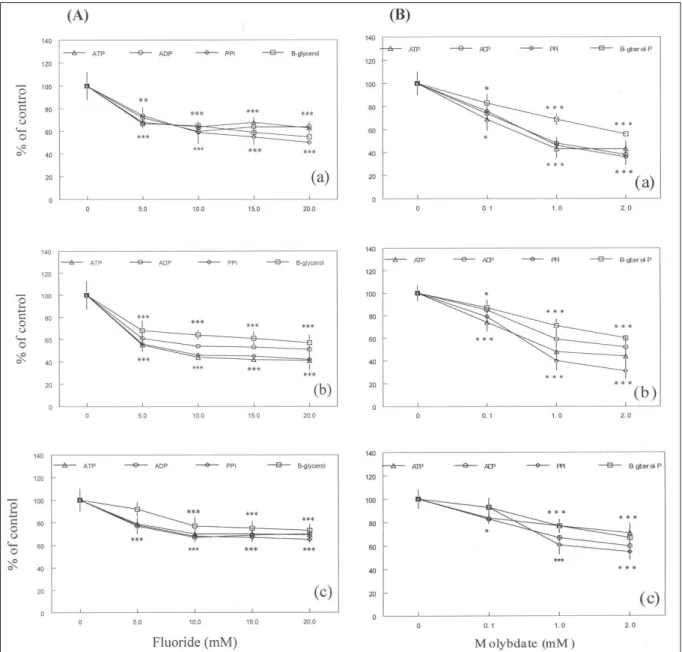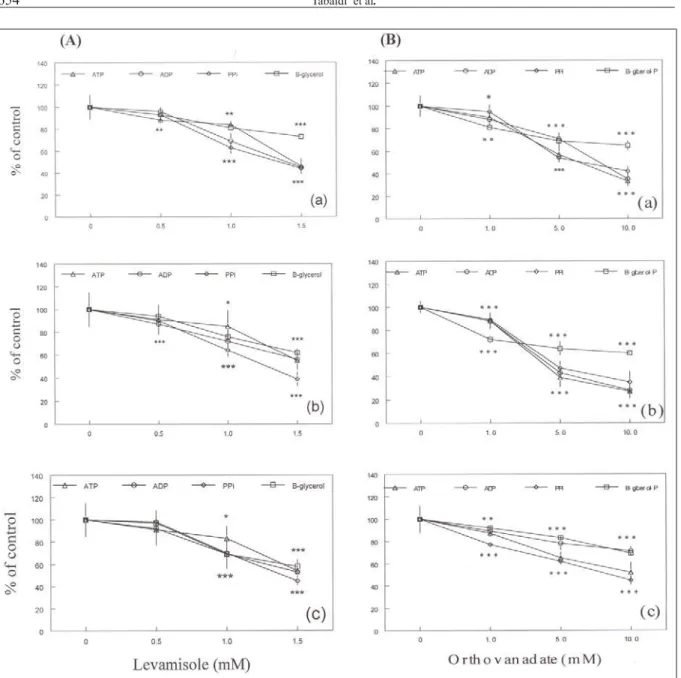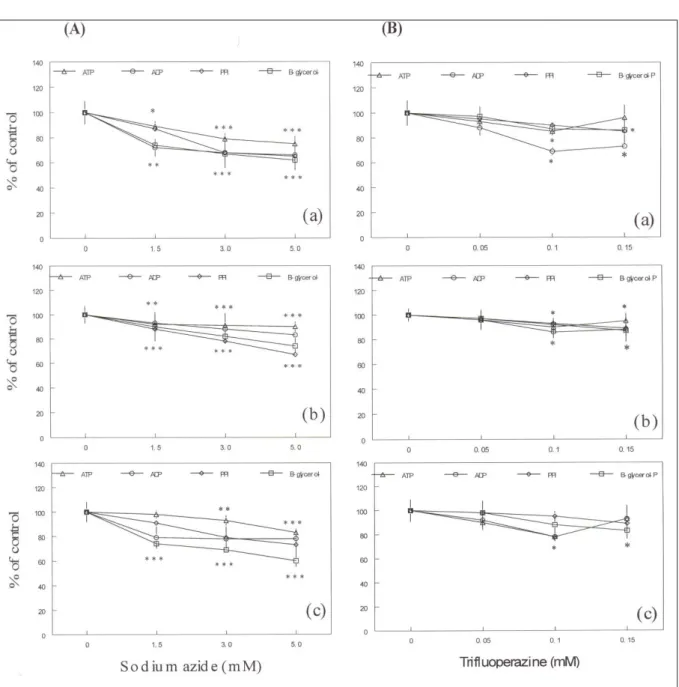ISSN 0103-8478
Presence of multiple acid phosphatases activity in seedlings of cucumber, radish and
rocket salad
Luciane Almeri TabaldiI Raquel RuppenthalI Luciane Belmonte PereiraI Denise CargneluttiI
Jamile Fabbrin GonçalvesI Vera Maria MorschI Maria Rosa Chitolina SchetingerI*
Presença de atividade de múltiplas fosfatases ácidas em plântulas de pepino, rabanete e rúcula
ABSTRACT
Acid phosphatases (3.1.3.2) are a group of enzymes widely distributed in nature, which catalyze the hydrolysis of a variety of phosphate esters in the pH range of 4-6. We confirmed the presence of acid phosphatases in seedlings of cucumber (Cucumis sativus), radish (Raphanus sativus) and rocket salad (Eruca vesicaria) under different assay conditions using a rapid and simple preparation. The results showed that the optimum pH and temperature used for all species were close to 5.5 and 35ºC, respectively. The enzyme was inhibited by molybdate, fluoride, azide, levamisole, orthovanadate, Zn2+ and Cu2+.
Suramin had no effect on enzyme activity. The acid phosphatase from cucumber, radish and rocket salad hydrolyzed a wide variety of phosphate esters and the highest activity was observed with PPi, ATP and GTP. These results demonstrate that the enzyme investigated in this study is different from well known ester phosphate cleaving plant enzymes (apyrase and inorganic pyrophosphatases) and this preparation could be a useful tool to future toxicological studies and to study initially all isoforms of acid phosphatase.
Key words: Cucumis sativus, Raphanus sativus, Eruca vesicaria, phosphatases.
RESUMO
As fosfatases ácidas (3.1.3.2) são um grupo de enzimas amplamente distribuídas na natureza, as quais catalisam a hidrólise de uma variedade de ésteres de fosfato com uma variação de pH entre quatro e seis. Foi confirmada a presença de fosfatases ácidas em plântulas de pepino (Cucumis sativus), rabanete (Raphanus sativus) e rúcula (Eruca vesicaria) sob diferentes condições de ensaio usando uma preparação rápida e simples. Os resultados mostraram que o pH e a temperatura ótimos para todas as espécies foram 5,5 e 35ºC, respectivamente. A enzima foi inibida por molibdato, fluoreto, azida, levamisole, ortovanadato, Zn2+ e Cu2+. O inibidor
suramim não afetou a atividade enzimática. As fosfatases ácidas
de pepino, rabanete e rúcula hidrolisaram uma ampla variedade de ésteres de fosfato e a maior atividade foi observada com PPi, ATP e GTP para pepino e rabanete e PPi, frutose-6-fosfato e GTP para rúcula. Esses resultados demonstraram que a enzima investigada neste estudo é diferente das conhecidas enzimas de plantas que clivam ésteres de fosfato (apirase e pirofosfatases inorgânicas). Desse modo, esta preparação pode ser uma ferramenta útil para futuros estudos toxicológicos e para se estudar inicialmente todas as isoformas das fosfatases ácidas.
Palavras-chave: Cucumis sativus, Raphanus sativus, Eruca vesicaria, fosfatases.
INTRODUCTION
Phosphate plays a vital role in energy transfer and in metabolic regulation. In addition, it has an important role as a constituent of macromolecules such as phospholipids, proteins and nucleic acids. Under conditions of phosphate limitation, the growth and development of plants are particularly damaged (LEFEBVRE et al., 1990).
Acid phosphatases (E.C. 3.1.3.2) are a group of enzymes that catalyze the hydrolysis of a variety of phosphate esters in acidic environments (PARK & VAN ETTEN, 1986). These enzymes are widely distributed in plants and are related to phosphate supply and metabolism from a vast array of phosphate esters (OLCZAK et al., 2000). In particular, plant acid phosphatases are ubiquitous and have been characterized in roots (PENHEITER et al., 1997), tubers (GELLATLY et al., 1994), seeds (PARK & VAN ETTEN,
IDepartamento de Química, Centro de Ciências Naturais e Exatas (CCNE), Universidade Federal de Santa Maria (UFSM),
651
Presence of multiple acid phosphatases activity in seedlings of cucumber, radish and rocket salad.
1986), leaves (STASWICK et al., 1994), and suspension cells (LEFEBVRE et al., 1990). Most plant acid phosphatases show little substrate specificity, exhibit an optimum pH below 6.0, are usually present in multiple forms, and display different biochemical properties (AOYAMA et al., 2001).
In plants, many roles have been postulated for these enzymes, including the release of inorganic phosphate from organic phosphate in the environment (AOYAMA et al., 2001). Several studies have demonstrated that phosphate deficiency in the immediate environment can cause an increase in extracellular phosphatase activity.
Consequently, studies that contribute to a better understanding of the role of acid phosphatases in plants are of particular importance. The objective of the present investigation was to confirm the presence of an acid phosphatase activity in crude and simple preparation to be posterior used in rapid toxicological test in three developing plant species (9 days after germination): Cucumis sativus(cucumber), Raphanus
sativus radicula (radish) and Eruca vesicaria sativa
(rocket salad). These plant species were selected because they have an easy germination in laboratory and are vastly consumed among the population all over the world.
MATERIAL AND METHODS
Seeds of cucumber (Cucumis sativus), radish (Raphanus sativus) and rocket salad (Eruca
vesicaria) were germinated on filter paper and seedlings
maintained at a regulated temperature (22-25°C) and photoperiod (12h/12h). The seedlings make use of seed nutrient in initial stage of the development and it was verified in an initial experiment that, in initial stage, the plants did not suffer severe nutritious deficiency. Samples (whole plants) were collected in the interval of 3 to 15 days after germination. Tissues were ground with a mortar and pestle and the homogenate was filtered and then centrifuged at 43.200 x g for 30 minutes. The supernatant was used for enzyme assay.
The total acid phosphatases activity was determined according to TABALDI et al. (2007). Enzyme specific activities are reported as nmol Pi released/min/ mg protein. Assays to determine the pH optimum were done as follow: in the 4.0-6.0 pH range, 100mM citrate buffer was used, in the ranges of pH 7.0-9.0 and pH 10.0-11.0, 100mM Tris/HCl and glycilglycine were used, respectively, with ATP, ADP, PPi and β-Glycerol phosphate as substrates. Assays to determine the temperature optimal were performed at 15, 25, 37 and 45°C with ATP, ADP, PPi and β-Glycerol phosphate as substrates. Protein was measured by the Coomassie blue method according to BRADFORD (1976).
Substrate curves were determined in the presence of 0.05-5.0mM ATP, ADP and PPi as substrates. ATP, ADP, AMP, bis-ρNPP, β-Glycerol phosphate, GTP, fructose-6-phosphate and PPi were used as substrates to determine the substrate specificity to the acid phosphatases activity, each one at a final concentration of 3.0mM.
The sensitivity of acid phosphatases from cucumber, radish and rocket salad to different inhibitors was tested with ATP, ADP, PPi and ß-glycerol phosphate as substrate. The inhibitors tested were sodium azide (1.5-5.0mM), sodium fluoride (5.0-20mM), orthovanadate (1.0-10mM), levamisole (0.5- 1.5mM), suramin (0.03-0.3mM), trifluoperazine (0.05-0.15mM), and ammonium molybdate (0.1-2.0mM). Divalent cations, calcium, magnesium, cupper and zinc were tested at the 1.0 to 10mM range in the incubation medium with EDTA (5.0mM). Data were analyzed statistically by one-way analysis of variance followed by the Duncan test when the F test was significant.
RESULTS
Seedlings at 9 days of age were used for the enzymatic assays for all species because it presented the highest activity (data not shown). The effect of pH on enzymatic activity of total acid phosphatase, using ATP, ADP PPi or ß-glycerol phosphate as substrate, is presented in figure 1A. Activity was maximal at pH 5.0-6.0, and sharply decreased at higher pH values. The pH selected for the incubation medium for total acid phosphatases was 5.5.
The effect of temperature on the activity of total acid phosphatases from cucumber, radish and rocket salad with ATP, ADP, PPi or ß-glycerol phosphate as substrate is showed in figure 1B. The enzyme from all species showed maximal activity near 37ºC, decreasing at higher temperatures. The temperature of 35ºC was considered to be safe and was used for later assays.
Total acid phosphatases from cucumber, radish and rocket salad presented a broad substrate specificity (Table 1), showing decreasing order of specificity towards PPi> GTP> ATP> fructose-6-phosphate> ADP> AMP> β-glycerol fructose-6-phosphate> bis-pNPP in cucumber, PPi> ATP> GTP> β-glycerol phosphate> AMP> fructose-6-phosphate> ADP> bis-pNPP in radish and PPi> fructose-6-phosphate> GTP> ATP> β-glycerol phosphate> bis-pNPP> AMP> ADP in rocket salad.
Figure 1 - Effect of pH (A) and temperature (B) on the activity of total acid phosphatase in cucumber (a), radish (b) and rocket salad (c). For temperature, the specific activity that represents 100% was 91±3, 177±6 and 132±3 for ATP hydrolysis, 96±1, 165±8 and 160±8 for ADP hydrolysis, 260±10, 489±1 and 341±2 for PPi hydrolysis and 157±9, 288±3 and 289±1 nmol Pi/min per mg protein for â-glycerol phosphate hydrolysis for cucumber, radish and rocket salad, respectively. Data represent the mean ± SEM of three different experiments.
Table 1 - Substrate specificity of total acid phosphatase in cucumber, radish and rocket salad a.
Relative activity (%) Substrate (3mM)
Cucumber Radish Rocket salad
ATP 100 100 100
ADP 68 33 64
GTP 137 68 108
AMP 64 37 65
Β-Glycerol phosphate 60 53 84
Bis-pNPP 48 18 83
Fructose-6-phosphate 85 34 112
PPi 248 103 210
a Results represent the means for at least three different preparations. The specific activity that represents 100% (ATP) was 281±6, 965±8 and
653
Presence of multiple acid phosphatases activity in seedlings of cucumber, radish and rocket salad.
studied in cucumber, radish and rocket salad. The enzyme was inhibited by typical phosphatases inhibitors (OLCZAK et al., 2000) such as fluoride (Figure 2A), molybdate (Figure 2B) and levamisole (Figure 3A), with inhibition occurring at all concentrations tested (P < 0.05), except with levamisole at 0.5mM in rocket salad. Orthovanadate, an inhibitor of acid phosphatase (BABU et al., 2002), also inhibited the acid phosphatases in all preparations tested (Figure 3B).
Sodium azide, an inhibitor of mitochondrial ATPase (F type ATPase) (PEDERSEN, 1975), inhibited ATP, ADP, PPi and ß-glycerol phosphate hydrolysis in all preparations tested, with more pronounced inhibition at concentrations of 3.0 and 5.0mM (Figure 4A) (P < 0.05). Suramin (0.03-0.3mM), an apyrase inhibitor (SCHETINGER et al., 2001) did not affect ATP, ADP, PPi or ß-glycerol phosphate hydrolysis at any of the concentrations tested (data not shown), while trifluoperazine, an inhibitor of membrane Ca2+-ATPase,
inhibited only at concentrations of 0.1 and 0.15mM. At 0.1mM, trifluoperazine inhibited the hydrolysis of ATP and ADP in cucumber and rocket salad, and the hydrolysis of ATP, ADP and PPi in radish. Trifluoperazine also inhibited ADP and PPi hydrolysis in cucumber, with all substrates in radish and of PPi and with ß-glycerol phosphate in rocket salad at 0.15mM (Figure 4B).
In addition, some divalent cations such as Cu2+, Zn2+, Ca2+ and Mg2+ (1.0, 2.5, 5.0 and 10.0mM)
were tested with EDTA (5.0mM) (Table 2). In such condition, Cu2+ and Zn2+ had inhibitory actions on the
enzyme activity at high concentrations (10mM) in cucumber, radish and rocket salad. However, Ca2+ and
Mg2+ had stimulatory effects when used at 2.5mM and
5.0mM plus EDTA 5.0mM. Therefore, in all assays we
655
Presence of multiple acid phosphatases activity in seedlings of cucumber, radish and rocket salad.
added a divalent cation (Ca2+) at 2.5mM plus EDTA
5.0mM.
DISCUSSION
Total acid phosphatases from these three species presented a similar response in terms of germination time to obtain the highest activity, pH,
temperature, incubation time and effect of inhibitors, and a distinct response in terms of substrate specificity. A period of nine days after germination was selected for the assays because it presented the highest activity. The best temperature for acid phosphatases incubation was 37ºC, being similar to that described for some plant acid phosphatases, such as barley roots (30-35ºC) (PANARA et al., 1990), and cotton seed (37ºC)
(BHARGAVA & SACHAR, 1987). We preferred to work at 35ºC to avoid some thermal inactivation, as observed at temperatures higher than 37ºC (Figure 1B).
In the pH dependence study with 3mM ATP, ADP, PPi or ß-glycerol phosphate as substrate, acid phosphatases presented the same range of optimum pH for cucumber, radish and rocket salad, with maximal activity around pH 5.0-6.0, decreasing in the pH range above 7.0. These data are closely related to those obtained using ρNPP as substrate in the phosphatase from sunflower seeds (PARK & VAN ETTEN, 1986). The pH dependence of the enzyme activity may be an important aspect of the control of plant metabolism (FERREIRA et al., 1999).
The acid phosphatases for the three species were inhibited by molybdate, fluoride, azide, levamisole, orthovanadate, and, to a lesser extent, by trifluoperazine. Suramin had no effect on the enzyme activity. Molybdate and fluoride are strong plant acid phosphatase inhibitors (FERREIRA et al., 1999), inhibiting also the acid phosphatase in yellow lupin seeds (OLCZAK et al., 2000). The results obtained with Zn2+ and Cu2+ were similar to those reported in the
literature, with these divalent cations being potent inhibitors of soybean acid phosphatases (FERREIRA et al., 1999). In tests carried out in our laboratory, Zn2+
was one of the most potent inhibitors of acid phosphatases in cucumber seedlings (TABALDI et al., 2007). However, when some metals such as calcium and magnesium were used with EDTA, they acted as activators of acid phosphatases. Taken together, the results obtained with the study of pH and of the effects of inhibitors and divalent cations confirm the predominant presence of acid phosphatases in our preparation.
Acid phosphatase has been shown to have broad substrate specificity, with PPi, ATP and GTP as the preferred substrates. ATP and PPi have been shown to be the preferred substrates for a number of acid phosphatases already characterized. Acid phosphatases with wide substrate specificity are proposed to be involved in mining/recycling leaked P-containing compounds.
Thus, our results propose a possible new approach to acid phosphatases study in plants based on the metabolism of common phosphate donors in plants. In fact, in this study pure enzyme preparations were not used and, as a consequence, the presence of multiple isoforms is imprecise. It is known that crude extracts could contain multiple forms of acid phosphatases and the results obtained probably are an association among these isoforms. Moreover, the
Table 2 - Effect of metal ions and EDTA (5.0mM) on the activity of acid phosphatase from cucumber, radish and rocket salad, with ATP as substratea.
Relative activity (% of control) Addition
1.0mM 2.5mM 5.0mM 10.0mM
Mg2+ + EDTA 112* 129*** 112* 103
Ca2+ + EDTA 104 115** 121*** 106
Zn2+ + EDTA 111 107 86** 85**
Cu2+ + EDTA 113 95 91 85
Cucumber
EDTA 62*** 55*** 45*** 35***
Mg2+ + EDTA 110*** 131*** 109*** 99
Ca2+ + EDTA 101 124*** 132*** 104
Zn2+ + EDTA 99 108 101 91***
Cu2+ + EDTA 104 99 94 84***
Radish
EDTA 97 95 84** 75***
Mg2+ + EDTA 119*** 128*** 122*** 104
Ca2+ + EDTA 106 126*** 151*** 100
Zn2+ + EDTA 101 108 101 82***
Cu2+ + EDTA 104 87*** 81*** 72***
Rocket Salad
EDTA 81*** 80*** 71*** 65***
a
657
Presence of multiple acid phosphatases activity in seedlings of cucumber, radish and rocket salad.
crude extract was likely to contain factors that affect the enzymatic activity of this enzyme. However, it did not decline the importance of the results obtained in this work.
From all the data presented above, we may conclude that acid phosphatase from cucumber, radish and rocket salad is a nonspecific enzyme responding similarly to a variety of factors. This enzyme has been studied in plants because of its involvement in the metabolism of phosphorus, which is essential for normal growth and development of plant organs. Therefore, this preparation could be a useful tool to future toxicological studies and to study initially all isoforms of acid phosphatase.
REFERENCES
AOYAMA, H. et al. Endogenous lectin as a possible regulator of the hydrolysis of physiological substrates by soybean seed acid phosphatase. Phytochemistry, v.58, p.221-225, 2001.
BABU, M.M. et al. Shigella apyrase – a novel variant of bacterial acid phosphatase? FEBS Letters, v.512, p.8-12, 2002.
BHARGAVA, R.; SACHAR, R.C. Induction of acid phosphatase in cotton seedlings: enzyme purification, subunit structure and kinetic properties. Phytochemistry, v.26, p.1293-1297, 1987.
BRADFORD, M.M. A rapid and sensitive method for the quantitation of microgram quantities of protein utilizing the principle of protein-dye binding. Analytical Biochemistry, v.72, p.248-254, 1976.
FERREIRA, C.V. et al. Glycolytic intermediates as substrates of soybean acid phosphatase isoforms. Plant Science, v.147, p.49-54, 1999.
GELLATLY, K. et al. Purification of a potato tuber acid phosphatase having characteristics of a protein tyrosine phosphatase. Plant Physiology, v.106, p.223-232, 1994.
LEFEBVRE, D.D. et al. Response to phosphate deprivation in Brassica nigra suspension cells. Enhancement of intracellular, cell surface and secreted phosphatase activities compared to increases in Pi-absorption rate. Plant Physiology, v.93, p.504-511, 1990.
OLCZAK, M. et al. Characterization of diphosphonucleotide phosphatase/phosphodiesterase from yellow lupin (Lupinus luteus) seeds. Biochimica et Biophysica Acta, v.1478, p.239-247, 2000.
PANARA, F. et al. Multiple forms of barley root acid phosphatase: purification and some characteristics of the major cytoplasmic isoenzyme. Biochimica et Biophysica Acta, v.1037, p.73-80, 1990.
PARK, H.C.; VAN ETTEN, R.L. Purification and characterization of homogeneous sunflower seed acid phosphatase. Phytochemistry, v.25, p.351-357, 1986.
PEDERSEN, P.L. Mitochondrial adenosine triphosphatase. Bioenergetics, v.6, p.243-275, 1975.
PENHEITER, A.R. et al. Soybean root nodule and acid phosphatase. Plant Physiology, v.114, p.597-604, 1997.
SCHETINGER, M.R.C. et al. ATP and ADP hydrolysis in fish, chicken and rat synaptosomes. Comparative Biochemistry and Physiology, v.128, p.731-741, 2001.
STASWICK, P.E. et al. Purification of the major soybean leaf acid phosphatase that is increased by seed-pod removal. Plant Physiology, v.104, p.49-57, 1994.




